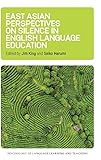East Asian Perspectives on Silence in English Language Education / ed. by Jim King, Seiko Harumi.
Material type: TextSeries: Psychology of Language Learning and TeachingPublisher: Bristol ; Blue Ridge Summit : Multilingual Matters, [2020]Copyright date: ©2020Description: 1 online resource (192 p.)Content type:
TextSeries: Psychology of Language Learning and TeachingPublisher: Bristol ; Blue Ridge Summit : Multilingual Matters, [2020]Copyright date: ©2020Description: 1 online resource (192 p.)Content type: - 9781788926768
- 9781788926775
- 428.0071/05 23
- P57.E18 A84 2020
- online - DeGruyter
| Item type | Current library | Call number | URL | Status | Notes | Barcode | |
|---|---|---|---|---|---|---|---|
 eBook
eBook
|
Biblioteca "Angelicum" Pont. Univ. S.Tommaso d'Aquino Nuvola online | online - DeGruyter (Browse shelf(Opens below)) | Online access | Not for loan (Accesso limitato) | Accesso per gli utenti autorizzati / Access for authorized users | (dgr)9781788926775 |
Frontmatter -- Contents -- Figures -- Tables -- Contributors -- Acknowledgements -- Foreword: The Song of Silence -- 1. East Asian Perspectives on Silence in English Language Education: An Introduction -- 2. Silence, Talk and In-betweens: East Asian Students’ Responses to Task Challenge in an Australian University -- 3. Approaches to Interacting with Classroom Silence: The Role of Teacher Talk -- 4. Silence and Anxiety in the English-Medium Classroom of Japanese Universities: A Longitudinal Intervention Study -- 5. Examining L2 Learners’ Silent Behaviour and Anxiety in the Classroom Using an Approach Based on Cognitive- Behavioural Theory -- 6. Communicative Language Teaching and Silence: Chinese (Pre-service) Teachers’ Perspectives -- 7. Silence in Japanese Classrooms: Activities and Factors in Capacities to Speak English -- 8. Willing Silence and Silent Willingness to Communicate (WTC) in the Chinese EFL Classroom: A Dynamic Systems Perspective -- 9. Conclusion: Silence in EFL Classrooms Revisited -- Index
restricted access online access with authorization star
http://purl.org/coar/access_right/c_16ec
Silence is a key pedagogical issue in language education. Seen by some as a space for thinking and reflection during the learning process, for others silence represents a threat, inhibiting target language interaction which is so vital during second language acquisition. This book eschews stereotypes and generalisations about why so many learners from East Asia seem either reluctant or unable to speak in English by providing a state-of-the art account of current research into the complex and ambiguous issue of silence in language education. The innovative research included in this volume focuses on silence both as a barrier to successful learning and as a resource that may in some cases facilitate language acquisition. The book offers a fresh perspective on ways to facilitate classroom interaction while also embracing silence and it touches on key pedagogical concepts such as teacher cognition, the role of task features, classroom interactional approaches, pedagogical intervention and socialisation, willingness to communicate, as well as psychological and sociocultural factors. Each of the book’s chapters include self-reflection and discussion tasks, as well as annotated bibliographies for further reading.
Mode of access: Internet via World Wide Web.
In English.
Description based on online resource; title from PDF title page (publisher's Web site, viewed 25. Jun 2024)


